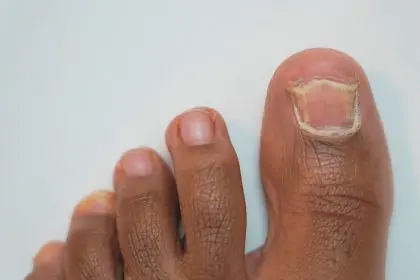You might think of your nails as merely cosmetic or practical features, good for scratching an itch or holding your favorite nail polish. But these small, seemingly simple structures actually serve as windows into your overall health. Long before other symptoms become obvious, your nails might be quietly signaling that something’s amiss inside your body.
Medical professionals have recognized this connection for centuries. Hippocrates, the father of modern medicine, documented nail abnormalities as diagnostic tools over 2,000 years ago. Today’s doctors still examine nails during physical exams, knowing that these keratinous structures can reveal surprising insights about conditions affecting organs you can’t see.
What makes nails such effective health indicators? They grow continuously, recording your body’s internal state like tree rings marking seasons. Changes in color, texture, shape, and growth patterns all tell stories about your circulation, nutrition, organ function, and more. While some nail changes are harmless variations or the result of minor trauma, others warrant closer attention and potential medical investigation.
The colors your nails turn when your body’s in trouble
Healthy nails typically appear pink with white tips, reflecting the rich network of blood vessels in the nail bed. Variations from this pattern can provide important clues about what’s happening inside your body.
Pale or white nails might indicate anemia, a condition where you have insufficient red blood cells or hemoglobin to carry oxygen effectively throughout your body. The lack of robust blood flow to nail beds removes their characteristic pink hue. This paleness often appears alongside other anemia symptoms like fatigue, weakness, and feeling cold, though nail changes might be noticed earlier.
Yellow discoloration often signals respiratory issues like chronic bronchitis or lung disease. The yellowing occurs when your lungs aren’t functioning optimally, affecting oxygen levels throughout your body. Fungal infections also cause yellowing, but these typically start at the nail tip and spread inward, while systemic causes usually affect the entire nail uniformly.
Bluish nails represent insufficient oxygen in your bloodstream, a condition called cyanosis. This alarming change suggests your cardiopulmonary system isn’t delivering adequate oxygen to your tissues. Heart problems, lung disease, or even extremely cold temperatures can trigger this color change. Blue nails, especially when accompanied by shortness of breath or chest pain, warrant immediate medical attention.
Brown or black streaks running vertically through nails raise concerns about melanoma, the most serious form of skin cancer. While people with darker skin naturally have benign pigmented bands, new or changing dark streaks should be evaluated by a dermatologist promptly. Unlike bruises, these streaks don’t grow out with the nail.
Half-white, half-pink nails, known as Terry’s nails, appear as if the bottom half of each nail is white while the tips remain pink. This distinctive pattern has strong associations with liver disease, particularly cirrhosis, but can also appear with congestive heart failure, kidney failure, or diabetes. The division typically creates a distinctive curved line rather than a straight border across the nail.
Red streaks in the nail bed, appearing as thin splinter hemorrhages, might indicate heart valve infections called endocarditis. These tiny blood vessels break under the nail when small blood clots from infected heart valves lodge there. While minor trauma can cause similar marks, splinter hemorrhages that appear across multiple nails without injury should prompt medical evaluation.
When your nail texture tells a health story
Beyond color changes, the texture and surface of your nails provide additional insights into your health status.
Pitting, which appears as small depressions in the nail surface as if someone poked the nail with a toothpick, strongly correlates with psoriasis. Interestingly, up to 50% of people with psoriasis develop nail changes, sometimes before skin symptoms appear elsewhere on the body. These pits may also occur with alopecia areata, an autoimmune condition causing hair loss, and connective tissue disorders.
Ridges running across the width of your nails, known as Beau’s lines, indicate periods when nail growth temporarily slowed or stopped due to serious physical stress. These horizontal indentations can develop after severe illness, major surgery, intense chemotherapy treatments, or significant physical trauma. Think of them as growth rings marking stressful periods your body endured.
Brittle, splitting nails that layer and peel might signal thyroid dysfunction, particularly hypothyroidism. When your thyroid gland doesn’t produce enough hormones, it affects protein synthesis throughout your body, including the keratin forming your nails. Iron deficiency and repeated exposure to moisture can cause similar problems, so context matters when evaluating this change.
Spoon-shaped nails, medically termed koilonychia, develop when nails become thin and curve upward at the edges, creating a depression that can hold a drop of water. This distinctive shape most commonly indicates iron deficiency anemia but can also appear with hemochromatosis, heart disease, and hypothyroidism. The spoon shape typically develops gradually as the condition progresses.
Clubbing, where fingertips enlarge and nails curve around fingertips in a dramatic downward fashion, signals chronic oxygen deprivation. Lung cancer, congenital heart disease, inflammatory bowel disease, and liver cirrhosis commonly cause this phenomenon. True clubbing represents more than just curved nails. The nail base feels spongy, and the angle between the nail and cuticle exceeds 180 degrees.
Excessive brittleness affects many people, particularly as they age, but extreme fragility to the point where nails can’t grow beyond the fingertip may indicate nutritional deficiencies. Insufficient biotin, iron, or protein can all manifest through weak, easily broken nails. Certain medications and repeated harsh chemical exposure can cause similar symptoms.
When nail growth patterns change course
The rate and manner in which your nails grow can provide additional health insights beyond color and texture changes.
Extremely slow nail growth often reflects peripheral circulation problems, where blood isn’t efficiently reaching your extremities. Conditions like Raynaud’s disease, peripheral artery disease, or uncontrolled diabetes can all manifest through dramatically reduced nail growth rates. While nails naturally grow more slowly with age, sudden changes deserve attention.
Nails that separate from the nail bed, a condition called onycholysis, create a white appearance as air enters the space beneath. While injury and fungal infections commonly cause this separation, thyroid disease represents a significant internal trigger, particularly hyperthyroidism. Psoriasis, certain medications, and autoimmune conditions can also lead to nail lifting.
Thickened, overgrown nails might indicate underlying circulation problems or fungal infections. When related to systemic issues rather than fungus, the thickening typically affects all nails uniformly rather than just one or two. Lung diseases and cardiovascular problems frequently manifest through thickened nails, as does psoriasis.
Beaded or bumpy nail growth, where the nail surface resembles a series of small beads or waves running from cuticle to tip, often correlates with inflammatory conditions like psoriatic arthritis or rheumatoid arthritis. These inflammatory disorders affect how keratin deposits during nail formation, creating an irregular surface.
Severely curved nails growing downward, sometimes called “ram’s horn nails” or onychogryphosis in extreme cases, may signal peripheral vascular disease or chronic respiratory conditions. This extreme curvature develops slowly, often affecting toenails more dramatically than fingernails. Poor circulation delivers insufficient nutrients to support normal nail growth, resulting in this distinctive pattern.
The nail-fungus connection to systemic health
While fungal nail infections might seem like merely cosmetic concerns, they sometimes offer important clues about your immune system health and circulation status.
Recurring fungal infections despite treatment might indicate underlying diabetes. Elevated blood sugar creates an environment where fungi thrive, while compromised circulation reduces your body’s ability to fight the infection locally. If fungal nail infections persist or return frequently, blood sugar testing might be warranted.
Widespread, treatment-resistant fungal infections can signal immune system dysfunction. HIV and other conditions affecting immunity often manifest through stubborn fungal infections that don’t respond to standard treatments. When multiple nails develop fungal infections simultaneously without clear causes like communal showers or nail salon exposure, immune function deserves evaluation.
Extremely slow healing after fungal infection treatment sometimes indicates peripheral vascular disease, where compromised blood flow to extremities hampers both immune response and healing. The same circulatory issues that slow nail growth also impede recovery from infections.
White spots or patches often misattributed to calcium deficiency actually indicate minor trauma in healthy individuals. However, consistent white spots appearing across multiple nails without injury might suggest fungal infection or, less commonly, systemic disease. The pattern and context of these white marks help determine their significance.
When to seek medical evaluation for nail changes
Not every nail abnormality requires medical attention, but certain changes warrant professional evaluation rather than watching and waiting.
New or changing dark streaks should be examined promptly to rule out melanoma. Unlike other nail changes that might develop gradually, dark streaks deserve immediate attention, particularly if they affect only one nail, are wider than 3mm, or blur at the borders.
Nail changes accompanied by other symptoms like fatigue, shortness of breath, or unexplained weight loss indicate the nail abnormality might be part of a broader health issue. These accompanying symptoms provide important context that helps your healthcare provider determine appropriate testing.
Pain, swelling, or redness around nails that develops without injury suggests infection that might require treatment. While minor infections typically remain localized, they can sometimes spread to deeper tissues if left untreated, particularly in individuals with diabetes or compromised immune function.
Sudden changes affecting multiple nails simultaneously often signal systemic rather than local causes. When several nails develop similar abnormalities within a short timeframe, internal factors are more likely contributing than external ones.
Severe changes in nail shape, particularly clubbing that develops over weeks or months, warrant thorough evaluation. True clubbing rarely occurs without significant underlying health issues, making it an important clinical sign that shouldn’t be ignored.
Supporting healthy nails from the inside out
While some nail changes reflect serious health conditions, many respond well to improved nutrition and proper care. Supporting nail health often benefits your entire body.
Adequate protein forms the foundation of nail health since keratin, the main nail component, is a protein. Ensuring sufficient daily protein through sources like poultry, fish, legumes, and dairy helps support normal nail structure and growth. Protein deficiency often manifests through weak, brittle nails before other symptoms become obvious.
Biotin, a B vitamin, plays a crucial role in keratin production. While severe biotin deficiency is rare, supplementation sometimes improves nail strength in people with brittle nails. Food sources include eggs, nuts, seeds, salmon, and avocados. As with any supplement, consult healthcare providers before starting biotin, particularly if you take medications.
Iron status significantly impacts nail health, with both deficiency and excess potentially causing abnormalities. Iron-rich foods include lean red meat, spinach, lentils, and fortified cereals. Because both insufficient and excessive iron cause problems, testing rather than blind supplementation provides the safest approach.
Zinc deficiency can lead to white spots and slow growth. Incorporating zinc-rich foods like oysters, beef, pumpkin seeds, and lentils supports both nail health and immune function. Severe zinc deficiency remains rare in developed countries but becomes more common with certain digestive conditions and strict vegetarian diets without proper planning.
Silica, though needed in only small amounts, contributes to nail strength. Foods like bananas, green beans, and whole grains provide this trace mineral that helps form cross-links in keratin. While many supplements target nail health with silica, obtaining it through food typically provides sufficient amounts.
Your nails provide a unique window into your internal health, silently reflecting conditions affecting organs you can’t see directly. By paying attention to these visible changes, you gain valuable insights that might help identify health issues before they progress. While not every ridge or spot indicates serious problems, understanding when changes warrant further investigation empowers you to be proactive about your health. The stories your nails tell deserve your attention, not just for beauty’s sake, but for the important health messages they might be sending.















